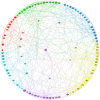Greenfield investments projects in manufacturing and electricity: A network analysis
- PMID: 40373159
- PMCID: PMC12080847
- DOI: 10.1371/journal.pone.0316647
Greenfield investments projects in manufacturing and electricity: A network analysis
Abstract
Aim of the paper: Greenfield is, by definition, foreign direct investment that creates new production facilities in the host countries, which imply an addition of fresh foreign capital. This paper brings empirical evidence about Greenfield global investment projects using network analysis in two key sectors: manufacturing and electricity. Our main research question is: What is the Greenfield Global Web of Investment Projects? And related to this main question: What is the center-periphery positions? How did the 2008 crisis affect it? Our secondary questions are: What are the web network properties? What does it tell us about the spread of investment intentions?.
Theoretical background: Network theory tell us, on one hand, that human decisions are made in the context of, and shaped by, web of interactions, and on the other, how dense network is, whether some groups are segregated and who sits in central positions, affects how information spreads and how people behave, and how linked agents interact with other linked agents, the outcomes ultimately depend on the entire network structure. This paper presents an original approach, combining different clustering methods in one figure. One is the Louvain without weights (once everything is measured in terms of indegree) using the concept of modularity. The other is positional analysis by blockmodeling.
Data and results: Our data source is Financial Times (FT) Greenfield investments data base (2003-2016). FT is the most authoritative source of intelligence on real investment in the global economy, and the only source of Greenfield investment data that covers all countries and industries worldwide. The World Bank, Unctad, the Economist Intelligence Unit and more than 100 governments around the world as well as major corporations use the data as the primary source of intelligence on Greenfield investment trends. Our variables are investment projects intentions value and country origin by year. Our analytical technics are network indicators at exploratory level and blockmodel. We clear answer our research questions in the Analysis of the features of the Networks sections. We also highlight that i) the 2008 crisis had a deep impact on the networks equilibrium, ii) it was substantially deeper in electricity than in manufacturing, which suggests that manufacturing web of investment projects was more resilient to exogenous shock, iii) global intentions of investment cohesion and core-periphery relations increased after crises in both sectors. There are also some secondary, but important results: from the network indicators, there was more ties after crises, the network were smaller, the information reached easily, central countries importance in the expectation formation increased substantially in manufacturing but unchanged in electricity, the information to the central countries became shorter after crises, and the flow of expectation sent between dissimilar increases after crises.
Copyright: © 2025 Silva Jr et al. This is an open access article distributed under the terms of the Creative Commons Attribution License, which permits unrestricted use, distribution, and reproduction in any medium, provided the original author and source are credited.
Conflict of interest statement
The authors have declared that no competing interests exist.
Figures






References
-
- Albino-Pimentel J, Dussauge P, El Nayal O. Intellectual property rights, non-market considerations and foreign R&D investments. Research Policy. 2022;51(2):104442. doi: 10.1016/j.respol.2021.104442 - DOI
-
- Amighini A A, McMillan M S, Sanfilippo M. FDI and Capital Formation in Developing Economies: New Evidence From Industry-Level Data. NBER-WP 23049; 2017.
-
- Aoki M. Institutions as cognitive media between strategic interactions and individual beliefs. Journal of Economic Behavior & Organization. 2011;79(1–2):20–34. doi: 10.1016/j.jebo.2011.01.025 - DOI
-
- Bachmann R, Elstner S. Firms’ optimism and pessimism. NBER. WP-18989; 2013:.
-
- Bachmann R, Elstner S, Sims ER. Uncertainty and economic activity: evidence from business survey data. NBER. WP-16143; 2010.
MeSH terms
LinkOut - more resources
Full Text Sources
Research Materials

